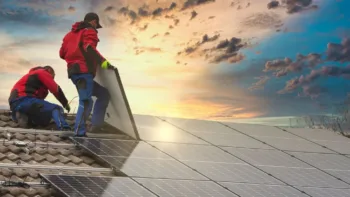
In today’s world, where environmental concerns are at the forefront of our collective consciousness, making green home upgrades is a responsible and rewarding choice. Not only do eco-friendly home improvements reduce your carbon footprint, but they also often save you money in the long run.
In this article, we’ll explore some simple yet impactful green home upgrades, from energy-efficient appliances to sustainable building materials, helping you transform your house into an environmentally friendly haven.
1. Energy-Efficient Appliances
One of the easiest ways to make your home more eco-friendly is by upgrading to energy-efficient appliances. Old, energy-guzzling machines can significantly contribute to your household’s energy consumption and greenhouse gas emissions.
Look for appliances with the ENERGY STAR label, which signifies their superior energy efficiency. These appliances use less energy to operate, which can reduce your electricity bills and carbon footprint simultaneously.
2. Solar Panels
Harnessing the power of the sun is a fantastic way to reduce your reliance on fossil fuels. Installing solar panels on your roof can generate clean, renewable energy for your home.
While the initial investment might seem daunting, government incentives and reduced energy bills can make this upgrade surprisingly affordable in the long run. Plus, you’ll be contributing to a more sustainable future.
3. LED Lighting
Swap out traditional incandescent bulbs for LED (Light Emitting Diode) lighting. LEDs are far more energy-efficient and have a much longer lifespan, meaning fewer replacements and less waste. They also provide bright, warm lighting, making your home both eco-friendly and aesthetically pleasing.
4. Smart Thermostats
A smart thermostat can revolutionize the way you control your home’s temperature. These devices learn your preferences and adapt accordingly, optimizing your heating and cooling systems for efficiency.
Some even allow you to control them remotely through your smartphone, ensuring you’re not wasting energy when you’re away from home.
5. Sustainable Flooring
When it comes to sustainable building materials, your flooring choices matter. Instead of traditional hardwood or carpet, consider eco-friendly options like bamboo, cork, or reclaimed wood. These materials are renewable and often produced with minimal environmental impact. Plus, they can add a unique and stylish touch to your home.
6. Low-Flow Plumbing Fixtures
Water conservation is another vital aspect of green home upgrades. Installing low-flow toilets, faucets, and showerheads can significantly reduce your water consumption. These fixtures are designed to maintain water pressure while using less water, saving you money on your water bills and helping conserve this precious resource.
7. Insulation and Windows
Proper insulation and energy-efficient windows are essential for maintaining a comfortable indoor temperature and reducing energy consumption.
Well-insulated walls, floors, and ceilings help prevent heat loss in the winter and keep your home cool in the summer. Energy-efficient windows with double or triple panes and low-emissivity coatings can further enhance your home’s energy performance.
8. Rain Barrels and Greywater Systems
Collecting rainwater in barrels for outdoor use and installing greywater systems to recycle water from sinks and showers for irrigation are smart eco-friendly strategies. These simple systems can reduce your reliance on potable water for non-drinking purposes, conserving this valuable resource.
9. Green Roof or Living Wall
For those looking to take their eco-friendly home upgrades to the next level, consider a green roof or living wall. These installations introduce vegetation into your home’s exterior, providing insulation, improving air quality, and even creating a natural habitat for wildlife.
10. Sustainable Landscaping
Finally, don’t forget your outdoor space. Choose native plants that require less water and maintenance, and consider xeriscaping to create a low-water landscape design.
Use organic fertilizers and pesticides sparingly or opt for eco-friendly alternatives to keep your garden environmentally responsible.
In conclusion, transforming your home into an eco-friendly haven is not only achievable but also highly beneficial for the environment and your wallet. By embracing green home upgrades, from energy-efficient appliances to sustainable building materials, you can reduce your carbon footprint, save on utility bills, and create a more comfortable and environmentally conscious living space.
Making these changes is a small step towards a brighter, greener future for us all.
By Admin –